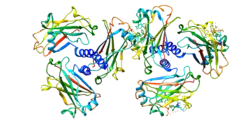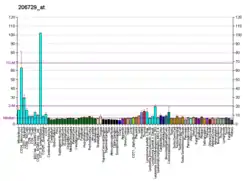CD30, also known as TNFRSF8 (TNF receptor superfamily member 8),[5] is a cell membrane protein of the tumor necrosis factor receptor family and a tumor marker.
Function
This receptor is expressed by activated, but not by resting, T and B cells. TRAF2 and TRAF5 can interact with this receptor, and mediate the signal transduction that leads to the activation of NF-kappaB.[6] It is a positive regulator of apoptosis,[7] and also has been shown to limit the proliferative potential of autoreactive CD8 effector T cells and protect the body against autoimmunity. Two alternatively spliced transcript variants of this gene encoding distinct isoforms have been reported.[5]
Clinical significance
CD30 is associated with anaplastic large cell lymphoma. It is expressed in embryonal carcinoma but not in seminoma and is thus a useful marker in distinguishing between these germ cell tumors.[8] CD30 and CD15 are also expressed on Reed-Sternberg cells typical for Hodgkin's lymphoma.[9]
Cancer treatment
CD30 is the target of the FDA approved therapeutic brentuximab vedotin (Adcetris). It is approved for use in:
- Hodgkin lymphoma (HL) (brentuximab vedotin) after failure of autologous stem cell transplant (ASCT)
- HL in patients who are not ASCT candidates after failure of at least 2 multiagent chemotherapy regimens
- Systemic anaplastic large cell lymphoma (sALCL) after failure of at least 1 multiagent chemotherapy regimen[10]
- Primary cutaneous anaplastic large cell lymphoma (pcALCL) or CD30-expressing mycosis fungoides (MF) who have received prior systemic therapy[11]
- Various types of CD30-positive T cell lymphomas[12]
Brentuximab vedotin is also currently being studied in and recommended for treating:
- Various types of CD30-positive B cell lymphomas[13]
- CD30-positive cases of the NK cell lymphoma, extranodal NK/T-cell lymphoma, nasal type[14]
Interactions
CD30 has been shown to interact with TRAF5,[6] and TRAF2.[6][7]
References
- 1 2 3 GRCh38: Ensembl release 89: ENSG00000120949 - Ensembl, May 2017
- 1 2 3 GRCm38: Ensembl release 89: ENSMUSG00000028602 - Ensembl, May 2017
- ↑ "Human PubMed Reference:". National Center for Biotechnology Information, U.S. National Library of Medicine.
- ↑ "Mouse PubMed Reference:". National Center for Biotechnology Information, U.S. National Library of Medicine.
- 1 2 "Entrez Gene: TNFRSF8 tumor necrosis factor receptor superfamily member 8". National Library of Medicine, National Center for Biotechnology Information. 22 September 2022. Retrieved 6 November 2022.
- 1 2 3 Aizawa S, Nakano H, Ishida T, Horie R, Nagai M, Ito K, et al. (January 1997). "Tumor necrosis factor receptor-associated factor (TRAF) 5 and TRAF2 are involved in CD30-mediated NFkappaB activation". The Journal of Biological Chemistry. 272 (4): 2042–2045. doi:10.1074/jbc.272.4.2042. PMID 8999898.
- 1 2 Duckett CS, Thompson CB (November 1997). "CD30-dependent degradation of TRAF2: implications for negative regulation of TRAF signaling and the control of cell survival". Genes & Development. 11 (21): 2810–2821. doi:10.1101/gad.11.21.2810. PMC 316646. PMID 9353251.
- ↑ Teng LH, Lu DH, Xu QZ, Fu YJ, Yang H, He ZL (Nov 2005). "[Expression and diagnostic significance of OCT4, CD117 and CD30 in germ cell tumors]". Zhonghua Bing Li Xue Za Zhi Chinese Journal of Pathology (in Chinese). 34 (11): 711–5. PMID 16536313.
- ↑ Gorczyca W, Tsang P, Liu Z, Wu CD, Dong HY, Goldstein M, Cohen P, Gangi M, Weisberger J (Feb 2003). "CD30-positive T-cell lymphomas co-expressing CD15: an immunohistochemical analysis". International Journal of Oncology. 22 (2): 319–24. doi:10.3892/ijo.22.2.319. PMID 12527929.
- ↑ Deng C, Pan B, O'Connor OA (Jan 2013). "Brentuximab vedotin". Clinical Cancer Research. 19 (1): 22–7. doi:10.1158/1078-0432.CCR-12-0290. PMID 23155186.
- ↑ "FDA approves Brentuximab vedotin for the treatment of adult patients with primary cutaneous anaplastic large cell lymphoma". FDA.gov. Retrieved March 2, 2018.
- ↑ "FDA approves first-line treatment for peripheral T-cell lymphoma under new review pilot". FDA.gov. 24 March 2020. Retrieved December 13, 2023.
- ↑ Berger GK, McBride A, Lawson S, Royball K, Yun S, Gee K, Bin Riaz I, Saleh AA, Puvvada S, Anwer F (January 2017). "Brentuximab vedotin for treatment of non-Hodgkin lymphomas: A systematic review". Critical Reviews in Oncology/Hematology. 109: 42–50. doi:10.1016/j.critrevonc.2016.11.009. PMC 5218629. PMID 28010897.
- ↑ Hu B, Oki Y (2018). "Novel Immunotherapy Options for Extranodal NK/T-Cell Lymphoma". Frontiers in Oncology. 8: 139. doi:10.3389/fonc.2018.00139. PMC 5937056. PMID 29761078.
Further reading
- Schneider C, Hübinger G (Jul 2002). "Pleiotropic signal transduction mediated by human CD30: a member of the tumor necrosis factor receptor (TNFR) family". Leukemia & Lymphoma. 43 (7): 1355–66. doi:10.1080/10428190290033288. PMID 12389614. S2CID 12699308.
- Horie R, Higashihara M, Watanabe T (Jan 2003). "Hodgkin's lymphoma and CD30 signal transduction". International Journal of Hematology. 77 (1): 37–47. doi:10.1007/BF02982601. PMID 12568298. S2CID 24727080.
- Tarkowski M (Jul 2003). "Expression and a role of CD30 in regulation of T-cell activity". Current Opinion in Hematology. 10 (4): 267–71. doi:10.1097/00062752-200307000-00003. PMID 12799531. S2CID 37330851.
- Granados S, Hwang ST (Jun 2004). "Roles for CD30 in the biology and treatment of CD30 lymphoproliferative diseases". The Journal of Investigative Dermatology. 122 (6): 1345–7. doi:10.1111/j.0022-202X.2004.22616.x. PMID 15175022.
- Dürkop H, Latza U, Hummel M, Eitelbach F, Seed B, Stein H (Feb 1992). "Molecular cloning and expression of a new member of the nerve growth factor receptor family that is characteristic for Hodgkin's disease". Cell. 68 (3): 421–7. doi:10.1016/0092-8674(92)90180-K. PMID 1310894. S2CID 7999537.
- Fonatsch C, Latza U, Dürkop H, Rieder H, Stein H (Nov 1992). "Assignment of the human CD30 (Ki-1) gene to 1p36". Genomics. 14 (3): 825–6. doi:10.1016/S0888-7543(05)80203-4. PMID 1330892.
- Josimovic-Alasevic O, Dürkop H, Schwarting R, Backé E, Stein H, Diamantstein T (Jan 1989). "Ki-1 (CD30) antigen is released by Ki-1-positive tumor cells in vitro and in vivo. I. Partial characterization of soluble Ki-1 antigen and detection of the antigen in cell culture supernatants and in serum by an enzyme-linked immunosorbent assay". European Journal of Immunology. 19 (1): 157–62. doi:10.1002/eji.1830190125. PMID 2537734. S2CID 29049745.
- Stein H, Gerdes J, Schwab U, Lemke H, Mason DY, Ziegler A, Schienle W, Diehl V (Oct 1982). "Identification of Hodgkin and Sternberg-reed cells as a unique cell type derived from a newly-detected small-cell population". International Journal of Cancer. 30 (4): 445–59. doi:10.1002/ijc.2910300411. PMID 6754630. S2CID 24167082.
- Jung W, Krueger S, Renner C, Gause A, Sahin U, Trümper L, Pfreundschuh M (Dec 1994). "Opposite effects of the CD30 ligand are not due to CD30 mutations: results from cDNA cloning and sequence comparison of the CD30 antigen from different sources". Molecular Immunology. 31 (17): 1329–34. doi:10.1016/0161-5890(94)90051-5. PMID 7527901.
- Shiota M, Fujimoto J, Semba T, Satoh H, Yamamoto T, Mori S (Jun 1994). "Hyperphosphorylation of a novel 80 kDa protein-tyrosine kinase similar to Ltk in a human Ki-1 lymphoma cell line, AMS3". Oncogene. 9 (6): 1567–74. PMID 8183550.
- Lee SY, Park CG, Choi Y (Feb 1996). "T cell receptor-dependent cell death of T cell hybridomas mediated by the CD30 cytoplasmic domain in association with tumor necrosis factor receptor-associated factors". The Journal of Experimental Medicine. 183 (2): 669–74. doi:10.1084/jem.183.2.669. PMC 2192463. PMID 8627180.
- Gedrich RW, Gilfillan MC, Duckett CS, Van Dongen JL, Thompson CB (May 1996). "CD30 contains two binding sites with different specificities for members of the tumor necrosis factor receptor-associated factor family of signal transducing proteins". The Journal of Biological Chemistry. 271 (22): 12852–8. doi:10.1074/jbc.271.22.12852. PMID 8662842.
- Horie R, Ito K, Tatewaki M, Nagai M, Aizawa S, Higashihara M, Ishida T, Inoue J, Takizawa H, Watanabe T (Oct 1996). "A variant CD30 protein lacking extracellular and transmembrane domains is induced in HL-60 by tetradecanoylphorbol acetate and is expressed in alveolar macrophages". Blood. 88 (7): 2422–32. doi:10.1182/blood.V88.7.2422.bloodjournal8872422. PMID 8839832.
- Aizawa S, Nakano H, Ishida T, Horie R, Nagai M, Ito K, Yagita H, Okumura K, Inoue J, Watanabe T (Jan 1997). "Tumor necrosis factor receptor-associated factor (TRAF) 5 and TRAF2 are involved in CD30-mediated NFkappaB activation". The Journal of Biological Chemistry. 272 (4): 2042–5. doi:10.1074/jbc.272.4.2042. PMID 8999898.
- Lee SY, Lee SY, Choi Y (Apr 1997). "TRAF-interacting protein (TRIP): a novel component of the tumor necrosis factor receptor (TNFR)- and CD30-TRAF signaling complexes that inhibits TRAF2-mediated NF-kappaB activation". The Journal of Experimental Medicine. 185 (7): 1275–85. doi:10.1084/jem.185.7.1275. PMC 2196258. PMID 9104814.
- Boucher LM, Marengère LE, Lu Y, Thukral S, Mak TW (Apr 1997). "Binding sites of cytoplasmic effectors TRAF1, 2, and 3 on CD30 and other members of the TNF receptor superfamily". Biochemical and Biophysical Research Communications. 233 (3): 592–600. doi:10.1006/bbrc.1997.6509. PMID 9168896.
- Duckett CS, Thompson CB (Nov 1997). "CD30-dependent degradation of TRAF2: implications for negative regulation of TRAF signaling and the control of cell survival". Genes & Development. 11 (21): 2810–21. doi:10.1101/gad.11.21.2810. PMC 316646. PMID 9353251.
- Mizushima S, Fujita M, Ishida T, Azuma S, Kato K, Hirai M, Otsuka M, Yamamoto T, Inoue J (Jan 1998). "Cloning and characterization of a cDNA encoding the human homolog of tumor necrosis factor receptor-associated factor 5 (TRAF5)". Gene. 207 (2): 135–40. doi:10.1016/S0378-1119(97)00616-1. PMID 9511754.
- Kurts C, Carbone FR, Krummel MF, Koch KM, Miller JF, Heath WR (Mar 1999). "Signalling through CD30 protects against autoimmune diabetes mediated by CD8 T cells". Nature. 398 (6725): 341–4. Bibcode:1999Natur.398..341K. doi:10.1038/18692. PMID 10192335. S2CID 19212457.
External links
- CD30+Antigens at the U.S. National Library of Medicine Medical Subject Headings (MeSH)
- Human TNFRSF8 genome location and TNFRSF8 gene details page in the UCSC Genome Browser.
This article incorporates text from the United States National Library of Medicine, which is in the public domain.





